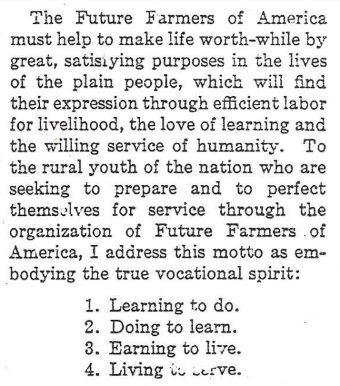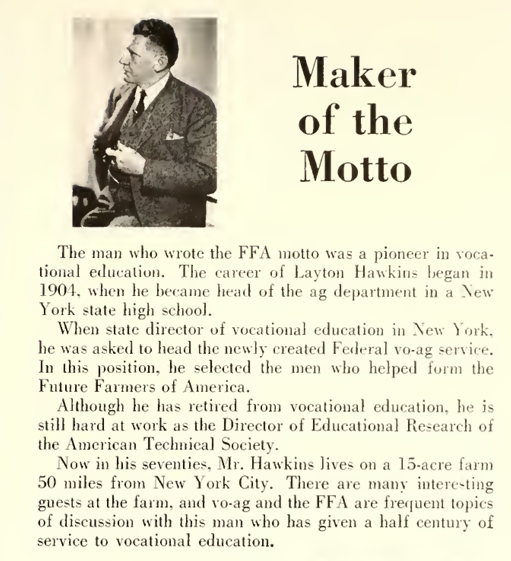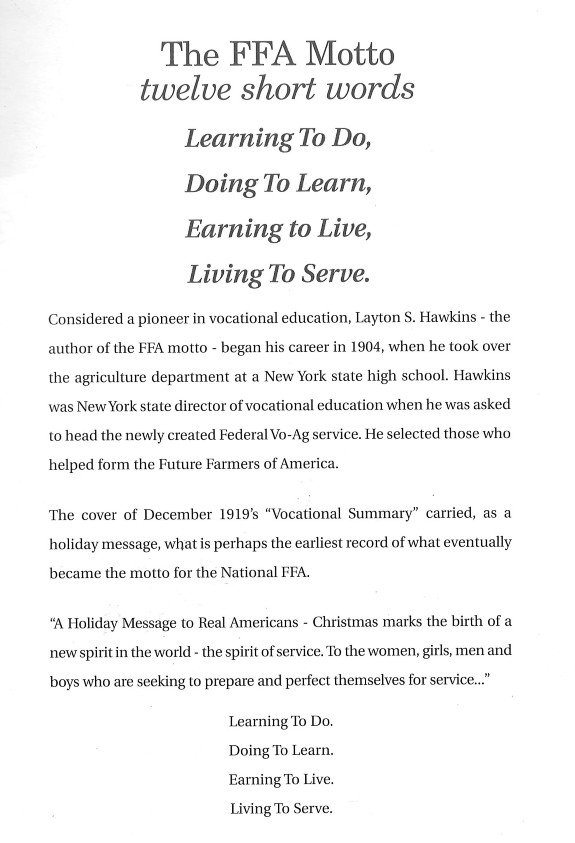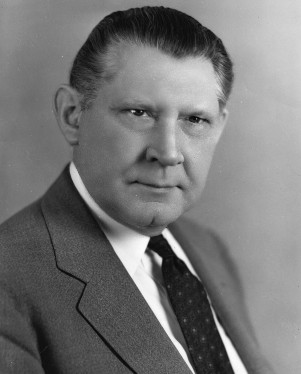I receive about one inquiry a week about the history of the FFA or Agricultural Education. Last week an agriculture teacher in Wisconsin wrote “My Quiz Bowl team would like to know Who created the FFA Motto. After asking teachers here, looking through FFA’s website and using Google I cannot find a definitive answer. Can you please help? Thank you very much.”
In 2017 I received a similar request. Here is that request:
I am a Master’s student in Dr. Craig Edward’s History and Philosophy of Agricultural and Extension Education course at Oklahoma State. We were visiting about my historical research narrative topic yesterday, and the question arose as to who was credited as the author of the FFA motto? We were not sure if it was an individual or a group of people. Dr. Edwards instructed me to contact you with the question. If you have any information that can help me answer the question, that would be very helpful.
I did answer the question both times. However, the most recent request caused me to think that perhaps the entire profession might benefit from knowing the answer to this question. Another reason for sharing this information with the profession is to right a wrong. For way to long the wrong person has been given credit for the FFA motto which is:
Learning to Do
Doing to Learn
Earning to Live
Living to Serve
The phrase “give credit where credit is due” is attributed to Samuel Adams in a letter he wrote in the late 18th century. Hopefully, this Footnote will “give credit where credit is due.”
Before we launch into the quest to identify the author of the FFA Motto, here are two thought questions.
Question 1: Of these five individuals, which two had the least to do with the adoption of the FFA Motto?
- Henry Groseclose
- Layton Hawkins
- John Hillison
- C. H. Lane
- E. M. Tiffany
Question 2: When did the FFA officially adopt the FFA Motto?
- 1928
- 1929
- 1930
- 1986
- The motto has never been officially adopted by the FFA.
Who Do People Think Was Responsible for the FFA Motto?
The first printed FFA Manual (1929-30 era) has an introduction from C. H. Lane who was Chief of the Agricultural Education Service of the Federal Board for Vocational Education and the National FFA Adviser. Here is the last paragraph of the introductory page written by C. H. Lane.

Figure 1. From the first FFA Manual
So it appears C. H. Lane came up with the motto. Later in the first manual we find a description of the emblem, the colors, and the creed. Since this motto was in the first manual it appears to be the de-facto motto.
The idea that C. H. Lane originated the motto was reinforced by newspaper articles. The March 20, 1929 Record-Journal of Meriden, Connecticut had an article about the founding and growth of the FFA. The last sentence in the article states that Dr. Lane gave the FFA boys a motto.

Figure 2. From the Record-Journal of Meriden, Connecticut, March 20, 1929. Did you catch the error?
A History of Agricultural Education of Less Than College Grade in the United States was published by the federal government in 1942. Rufus Stimson and Frank Lathrop compiled the information. Each state was responsible for writing their own histories. Chapter 7 of the book is titled “Student Organizations” and the section about the Future Farmers of America was written by W. A. Ross who was National Executive Secretary of the FFA. On page 546 Ross writes, “The motto suggested by C. H. Lane and adopted by the Future Farmers was: “Learning to do, doing to learn, earning to live, living to serve.”
Based on the above information it appears that C. H. Lane came up with the idea for the motto and it had been adopted by the organization (more about that later).
The belief that C. H. Lane is the originator of the FFA Motto carries through to the present. In the fourth edition (2022) of the book, Foundations of Agricultural Education we find this:
The FFA Motto is a short expression of the character of FFA and represents a quick and easy way to remember the mission of FFA. It reflects the pragmatic philosophy of work prevalent when C. H. Lane, the first National FFA advisor, recommended it to the National FFA Convention delegates.
Who is the Real Author of the FFA Motto?
When the Smith-Hughes Act was enacted in 1917, a Federal Board for Vocational Education was created to implement the Act and establish policies and procedures. One of the branches created within this organization was the “Agricultural Education Service” with seven employees. The head of this branch was Layton S. Hawkins. C. H. Lane worked under Hawkins as the Southern Region Agent.
Hawkins was born in 1877 in New York. He served as head of the Department of Science and Agriculture at Cortland State Normal School from 1904 to 1910. Then from 1910 to 1916 he was the Agricultural Education Specialist for the New York State Department of Education. From 1916 to 1917 he was state director of vocational education for New York.
One year (1918) after joining the Federal Board, Hawkins was promoted to be the Chief of the Vocational Education division of the Federal Board (C. H. Lane then was promoted to be the head of the Agricultural Education Service). The Federal Board published a monthly newsletter titled The Vocational Summary. This publication was widely disseminated across the nation. In December of 1919, Hawkins posted a Christmas message on the front cover. This message contained the motto we now know as the FFA motto (see below). The key point to note is this was published in 1919, nine years before the founding of the FFA and came from the pen (or perhaps typewriter) of Layton S. Hawkins.

Figure 3. The Vocational Summary, December, 1919
So where would one go to find that the National FFA officially recognizes Layton S. Hawkins as the author of the FFA Motto? There are only two mentions of him in the FFA world. The National Future Farmer magazine published in the Fall of 1953 (Volume 2, Number 1, page 21) contained a brief article about Layton Hawkins titled “Maker of the Motto” (see below).

Figure 4. The National Future Farmer, Fall, 1953.
The other mention of Layton Hawkins as the author of the FFA Motto is at the start of the 2003 book Blue Jackets Gold Standards, which is a history of the first 75 years of the FFA. The first few pages in the book are not numbered but this is where we find the following.

Figure 5. Introductory content from Blue Jackets Gold Standards
When was the FFA Motto Officially Adopted?
John Hillison, an agricultural education professor at Virginia Tech was on sabbatical leave in 1986 and was doing some historical research in Washington, DC. He ran across The Vocational Summary depicted earlier in this Footnote. His initial reaction was, and I quote, “those bastards, they stole our motto.” Then John saw the date on the Vocational Summary nine years prior to the founding of the FFA and then said “Whoops”.
Dr. Hillison was in the Washington, DC area when he made this discovery and then drove to the National FFA Center and looked at minutes from the FFA Board of trustees. He looked for several years but could not find where the motto was ever approved. I too have scoured the early documents and reached the same conclusion – the motto had never been adopted – that is until 1986.
John informed the FFA Board of Directors in 1986 that the motto had never been officially adopted. That is what precipitated a motion at the July 1986 FFA Board of Directors meeting. The FFA Board Minutes (1986, p. 19) reveal the Board voted to make the motto that has been in use since the founding of the FFA to be the official motto. Here is what is contained in the minutes.

Figure 6. From the FFA Board of Directors minutes, July 1986.
Concluding Remarks
As we prepare for National FFA Week it is time to “give credit to where credit is due.” Layton S. Hawkins should be recognized as the originator of the FFA Motto. There may be earlier mentions of those 12 words by someone at some point in time, but I cannot find them. C. H. Lane promoted the use of these words as the FFA motto, but they were not original with him.

Figure 7. Layton S. Hawkins
Now you know who wrote the FFA Motto. But what is more important is the message contained in these twelve words. I hope that when you teach your students about the FFA Motto you slow down and discuss and describe in great detail the meaning of each line in the motto. They are powerful.
In the spirit of giving credit where it is due, John Hillison should be recognized as the co-author of this Footnote. He first shared his story with me many years ago and we have been in constant contact during the past few weeks working on the Footnote. He provided invaluable information in preparing this Footnote. Then David Laatsch in Wisconsin helped verify it.
The answer to the two earlier questions, as if you haven’t already figured it out, were Groseclose and Tiffany were not involved in creating or adopting the motto and it was adopted in 1986.
